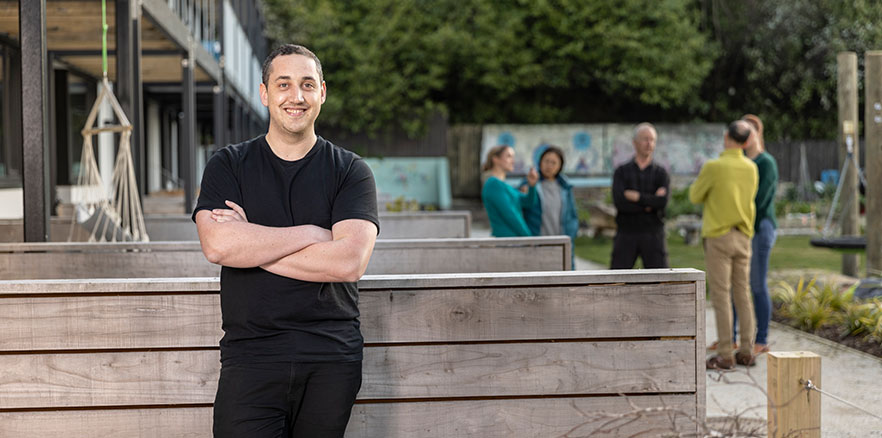
Dr James Berghan
Kaupapakāinga. It's a term coined by Dr James Berghan (Te Rarawa, Te Aupōuri) as part of his research into bringing together the best of western co-housing models and Māori approaches to papakāinga in shared living space.
“It is a kind of hybrid of co-housing and papakāinga but playing off the word kaupapa, meaning focus or purpose,” Berghan (Surveying) explains.
A former School of Surveying student, Berghan graduated in 2013 before heading to Hamilton where he became a Licensed Cadastral Surveyor.
While completing Honours he had explored different development uses and cultural attachments to Māori land, and as he worked professionally he realised housing solutions needed to offer more than the usual paradigm of ownership and individualism.
“That got me interested in more collective models of housing, in particular papakāinga from a Māori context. The more I looked at it the more similarities I saw with co-housing, and I started to ask whether there were lessons we could take from each of them that would enable urban papakāinga to be facilitated a bit more easily.”
Berghan says there are strong similarities, especially around the idea of the collective relationships and living more closely with your neighbours.
"I'd love to get to the point where they're no longer alternative housing models - they're just part of the suite of housing models that we have.”
“It's not going to that other extreme where everything is shared and totally communal. It's finding a balance between having individual, self-sufficient households that have all the facilities of a conventional home, but there are extras such as access to shared māra kai (communal gardens) and green space.”
It opens up opportunities for Māori who have lived away from the area to come back and reconnect with their whānau, hapū and iwi, he says.
“While it is a housing project it has a lot of social and cultural gains attached to it. For instance, there are indigenous communities overseas who have done similar housing programmes which has helped to foster language revitalisation.“
Berghan says the kaupapakāinga approach also covers how papakāinga might function if you're not mana whenua.
“For example, is there some other shared kaupapa that might bring a neighbourhood together, while reducing isolation and allowing sharing economies and being able to borrow things from neighbours, rather than having to own everything yourself?
“That's really starting to get into the co-housing space because many communities have a shared kaupapa, such as environmental sustainability,” he says.
“Could living with other Māori who don't whakapapa to that area still support language revitalisation and provide access to some of those cultural supports, without being on your own ancestral whenua?”
Berghan says a good example of this is a small cluster of eight kaumātua homes in Hamilton, built in a circle with a shared space in the middle.
“The kaumātua don't necessarily whakapapa to Waikato-Tainui, but they share a kaupapa of maintaining their independence but with easy access to the social and cultural benefits of living a bit more closely with one another.”
There are of course all sorts of legal, financial and even socio-cultural challenges, including the perception shared models like this are extreme, even when they are not.
Legal and financial challenges, such as being able to get a mortgage on collective land are still an issue, although it is becoming easier as ownership models change and more off-the-shelf solutions appear.
Local government also struggles at times with approaches that don't fit the traditional ownership models, but Berghan hopes all that can change.
“In a lot of this research we talk about these as alternative housing models, but I'd love to get to the point where they're no longer alternative housing models - they're just part of the suite of housing models that we have.”
Berghan enjoys strong collaborations with other University of Otago departments, including Public Health in Dunedin and Population Health at the University of Otago, Christchurch, with the health benefit of such housing models increasingly recognised.
He is also working with Te Koronga: Indigenous Science Research Theme and the Department of Psychology, exploring the value of green spaces in providing relief from the built environment.
This work is also spilling over into research involving Geography, with projects looking at streetscapes and indigenous identity in cities, including the mana whenua presence in Dunedin's George Street redevelopment.
Since being interviewed for this story Berghan has received a 2022 Curriculum Innovation award from the Lincoln Institute of Land Policy for his innovative teaching practices in a third-year urban design Surveying paper.
It is one of only four awards worth $US7,000, the others going to recipients from prestigious American universities, including the University of Michigan and Arizona State University.
Recent awards
- Curriculum Innovation Award from the Lincoln Institute of Land Policy (2022)
- Exceptional PhD Thesis (2020)
Funding
- Building Better Homes, Towns and Cities National Science Challenge
- Ageing Well National Science Challenge
- Healthier Lives National ScienceChallenge
- Te Koronga Indigenous Science Research Theme
- Ngā Pae o te Māramatanga Centre of Research Excellence
- BRANZ
- Lincoln Institute of Land Policy
More stories about early career researchers
This story is part of the research publication 'He Kitenga 2022: Talented Futures', which presents the different pathways into research that early career researchers follow.